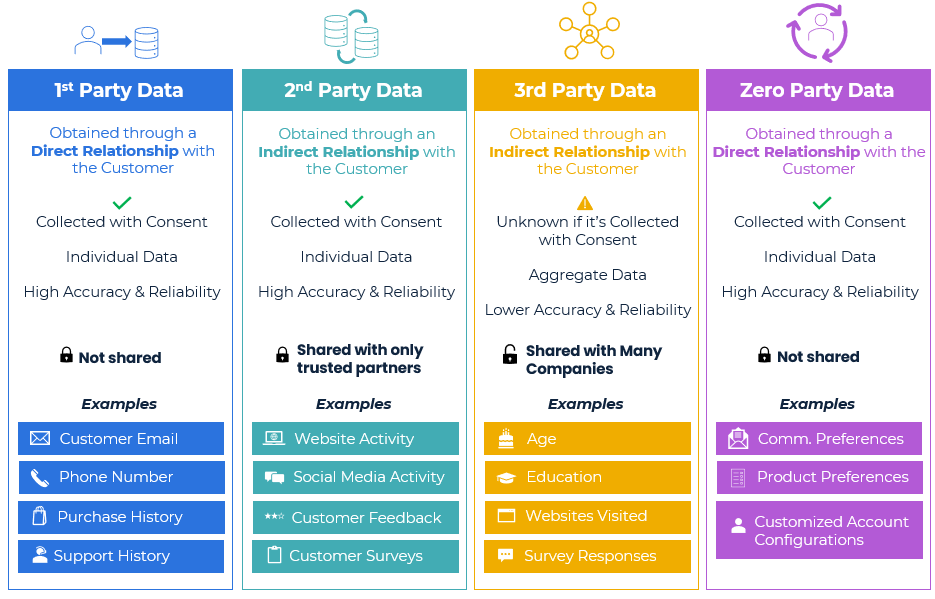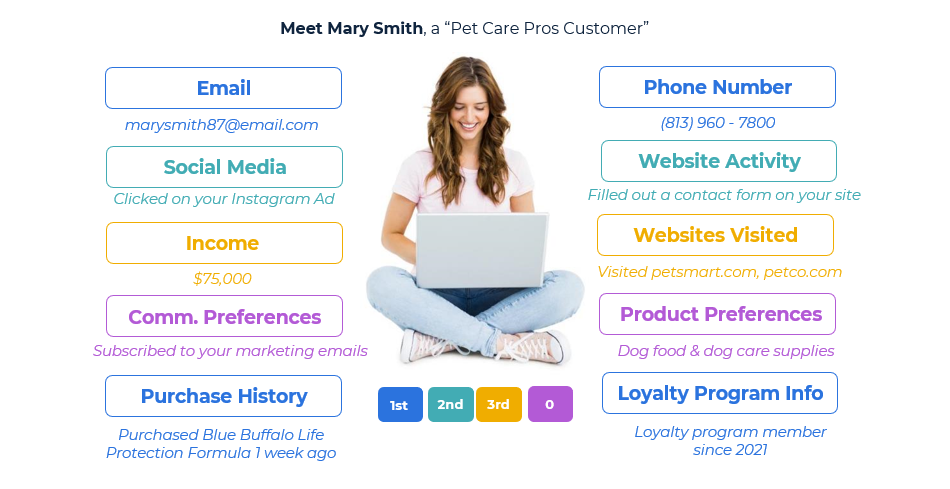First-party data provides a treasure trove of insights for your marketing. Because this data is directly collected from your customers, you can access deeper insights into customer behavior, preferences, and interactions. helping you form a solid foundation for personalized marketing strategies.
Benefits of First-Party Data
Unique advantages of first-party data include:
Enhanced Personalization: First-party data enables you to deliver highly targeted and personalized marketing campaigns tailored to customer preferences and behaviors.
Improved Customer Insights: Collecting customer data provides valuable insights into their behaviors, preferences, and interests to improve your marketing strategies.
Increased Trust and Loyalty: Utilizing first-party data demonstrates transparency and respect for customer privacy. This fosters trust and loyalty among customers who appreciate personalized and relevant interactions.
Better ROI: Targeted marketing efforts driven by first-party data typically yield higher conversion rates and ROI.
Compliance and Security: First-party data collection is inherently compliant with data privacy regulations and reduces the risk of data breaches since it’s collected directly from customers with their consent.
First-Party Data FAQs
Check out our FAQS to help you better understand first-party data and how it can help you build better campaigns and stronger customer relationships.
1. What Is First-Party Data?
First-party data is information collected with consent directly from your customers or users. This data is highly unique to your brand, providing a wealth of proprietary insights into your customer base.
2. How Is First-Party Data Different from Second-Party, Third-Party, and Zero-Party Data?
Second-Party Data: Second-party data is obtained through an indirect customer relationship (compared to first-party data, which is a direct customer relationship). This type of data is information that your brand didn’t collect but obtained through a trusted partner. Examples of first-party data include activity on websites, apps, and social media, survey responses, and more.
Third-Party Data: Third-party data is collected by external sources unrelated to your company. It’s aggregated data acquired from data providers or data aggregators. Third-party data is collected from various sources, such as public records, surveys, or online behavior tracking. While it provides a variety of insights, it may be less accurate or specific to your business.
Zero-Party Data: Similar to first-party data, zero-party data is collected with consent from your customers. Examples of zero-party include communication preferences, product preferences, and customized account configurations. Zero-party data is highly accurate and reliable, especially when combined with first-party data.

3. Why Is First-Party Data Valuable?
First-party data is invaluable because it offers insights into your audience’s behavior, preferences, and interactions with your brand. It enables you to create personalized experiences and drive engagement.
4. How Does Cookie Deprecation Impact the Importance of First-Party Data?
Advertisers have historically relied heavily on third-party cookies for tracking and targeting across the web. However, with the impending deprecation of third-party cookies by major browsers, such as Google Chrome, advertisers must find new targeting approaches. The good news is that first-party targeting is not dependent on third-party data sources that may be restricted or change over time.
5. How Can I Collect First-Party Data?
Methods to collect first-party data include website analytics, CRM systems, surveys, registration forms, customer feedback, social media interactions, and more.
According to research by Accenture, 83 percent of consumers would share preferences, interests, and demographic information directly with brands for a personalized experience. However, before you ask your customers to share their info, you need to clearly state what’s in it for them.
Offering discounts, attractive prizes, rewards, loyalty points, premium content, special offers, and more are great strategies to encourage data sharing. For example, offer a customer a freebie or a discounted offer on their birthday for sharing their birth date.
6. Is First-Party Data Compliant with Data Privacy Regulations?
Yes, when collected with consent and in compliance with data privacy regulations like GDPR and CCPA, first-party data is fully compliant. It’s essential to maintain transparency and offer opt-in/opt-out choices.
7. What Are Some Examples of First-Party Data Use Cases?
First-party data can be used for various purposes, such as improving customer support, email marketing personalization, segmenting audiences, and improving product recommendations.
8. How Can First-Party Data Improve Customer Engagement?
A 2021 Mckinsey & Company report found that 78 percent of consumers are more likely to make repeat purchases from brands that personalize. Additionally, nearly 80 percent are more likely to refer their family and friends to these companies.
First-party data helps you understand customers’ preferences, behaviors, and interests to deliver more engaging messages and provide better support. And because it’s your proprietary data that no other brand has access to, you can leverage these rich insights for your targeting.
8. Is First-Party Data Beneficial for Advertisers?
Absolutely! Advertisers can leverage first-party data for targeted advertising, ensuring their messages reach the most relevant audience segments, which can lead to higher conversion rates.
9. Can First-Party Data Help with Customer Retention?
Yes, first-party data allows you to identify loyal customers and develop retention strategies. You can offer special promotions, loyalty programs, and personalized recommendations to keep them engaged.
10. How Should I Safeguard First-Party Data?
Protecting first-party data is crucial. Employ robust cybersecurity measures, encrypt sensitive data, limit access to authorized personnel, and regularly audit data handling practices to maintain data integrity and security.
11. How Can I Ensure the Quality and Accuracy of My First-Party Data?
A regular cadence of data hygiene is important to maintain data quality and accuracy. First-party data is dynamic, and customer information changes over time. Regularly updating your dataset with the most recent information is crucial to maintaining accuracy. This might involve email verification, address updates, or monitoring changes in customer preferences.
12. What is All-Party Data?
First-party data is an important component of an “All-Party Data” strategy. This combines information from first, second, third, and zero-party sources to create a comprehensive customer view.

Your first-party data is a powerful marketing asset. Make it a priority to collect and leverage these insights to improve your targeting and provide better customer experiences.




